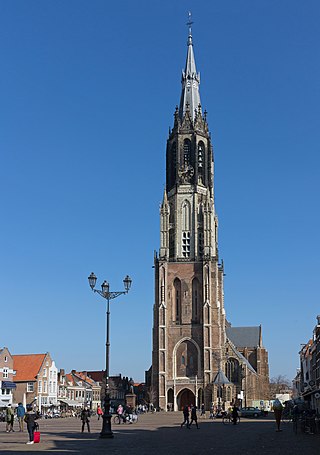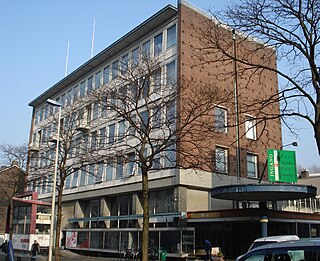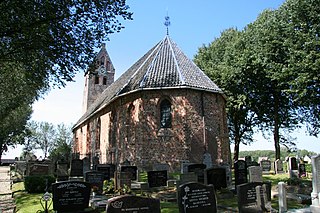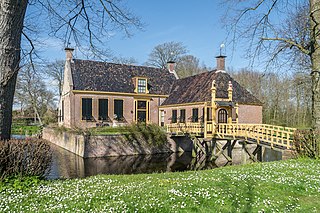
Heerenveen is a town and municipality in the province of Friesland (Fryslân), in the Northern Netherlands. In 2021, the town had a population of 29,790 while the municipality had a population 50,859.

Dendermonde is a city in the Flemish province of East Flanders in Belgium. The municipality comprises the city of Dendermonde and the towns of Appels, Baasrode, Grembergen, Mespelare, Oudegem, Schoonaarde, and Sint-Gillis-bij-Dendermonde. Dendermonde is at the mouth of the river Dender, where it flows into the Scheldt. The town has a long-standing folkloric feud with Aalst, south along the same river, which dates from the Middle Ages.

The Nieuwe Kerk is a Protestant church in the city of Delft in the Netherlands. The building is located on Delft Market Square (Markt), opposite to the City Hall. In 1584, William the Silent was entombed here in a mausoleum designed by Hendrick and Pieter de Keyser. Since then, members of the House of Orange-Nassau have been entombed in the royal crypt. The latest members to have been entombed are Queen Juliana and her husband Prince Bernhard in 2004. The private royal family crypt is not open to the public. The church tower, with the most recent recreation of the spire, was designed by Pierre Cuypers and completed in 1872. It is the second highest in the Netherlands, after the Domtoren in Utrecht.

Het Slaakhuis, or Slaakhuys, is a monumental building in Rotterdam, the Netherlands. It was the former offices of the socialist newspaper Het Vrije Volk. The building is a six-storey office block located on a street called Slaak and was squatted in May 2003. The snooker centre next door, which hosted greats such as Ronnie O'Sullivan was also later squatted. In 2011, the complex was evicted and by 2017 it had become a hotel and a Lidl supermarket.

Peperga is a small village in Weststellingwerf in the province Friesland of the Netherlands. As of 2017, it has a population of 85 people, living in approximately 35 houses, and is characterized by detached houses, several businesses and a church. Peperga is located on the A32 between Wolvega and Steenwijk, with public transportation offering a service to the nearby villages of Steggerda and De Blesse.

Allingawier is a small village in Súdwest-Fryslân municipality in the Dutch province of Friesland. It is about 7 km southwest of the city of Bolsward.

Balk is a town in the northern Netherlands. It is a village of the municipality De Fryske Marren, province Friesland, and is located about 17 km southwest of Sneek.

Jelsum is a village in Leeuwarden municipality in the province of Friesland, the Netherlands. It had a population of around 195 in January 2017. The stins Dekemastate is located in Jelsum.

Nooitgedacht is a smock mill in Veenoord, Drenthe, in the Netherlands, which has been restored to working order. The mill was built in 1916 and is listed as a Rijksmonument, number 33786.

Welgelegen or Tjepkema's Molen is a smock mill in Heerenveen, Friesland, Netherlands, which was built in 1849 and has been restored to working order. The mill is listed as a Rijksmonument, No. 21171.

The City Hall in Delft is a Renaissance style building on the Markt across from the Nieuwe Kerk. It is the seat of the city's government as well as a popular venue for civic wedding ceremonies. Most administrative functions have been transferred to an office inside the Delft railway station building. Originally designed by the Dutch architect Hendrick de Keyser, it was heavily changed over the centuries and was restored in the 20th century to its Renaissance appearance.

Grote or Sint-Laurenskerk is a landmark formerly Protestant church in Alkmaar, Netherlands, now in secular use. The building is located on the Koorstraat. It is mostly closed in the winter and open for tourists in the summer months or by appointment.

Beeckestijn is a historical buitenplaats dating from the 18th century in a park by the same name in Velsen-Zuid, Netherlands.

Grote of Sint-Laurenskerk is a Protestant church in Rotterdam. It is the only remnant of the medieval city of Rotterdam.

Willem Hendrickszoon de Keyser was a Dutch Golden Age architect and sculptor primarily active in Amsterdam and London.

Poptaslot or Heringastate is a stins—a type of luxurious house often used by and/or built for the nobility of Frisia, many of which are built to look like castles —in the Dutch province of Friesland (Fryslân). It was founded somewhere between 1512 and 1525, probably by Sasker van Camstra. It was probably named Heringastate when it was founded, using his mother’s surname Heringa. Around 1631 it was significantly changed and modernised. Its last inhabitant, Doctor Henricus Popta, declared that his house should never be lived in again and should be preserved. Today slot guardians, of which four are currently active, still preserve the stins.

The Oudezijds Voorburgwal, often abbreviated to OZ Voorburgwal, is a street and canal in De Wallen in the center of Amsterdam. It runs from the Grimburgwal in the south to the Zeedijk in the north, where it changes into the Oudezijds Kolk, which drains into the IJ.

The Martenahuis or Martenastins is a stins (estate) in the centre of the Dutch city of Franeker, Friesland. The building is located on the Voorstraat. The Martenahuis dates from 1502 when it was built by order of the chieftain Hessel van Martena. Since 2006, Museum Martena has been housed in the building.

The Dekemastate or Dekema State is a stins in the Dutch village of Jelsum, Friesland. It was probably built in the late 15th century on the location of a zaalstins from the 14th century. The estate currently functions as a museum.

The Liauckamastate or Liauckama State is a former stins near the Dutch village of Sexbierum, Friesland. It was one of Friesland's biggest estates and was inhabited by members of the Liauckama family. Of the old stins, only the gatehouse, farmhouse, and day labourer's house still stand.

























